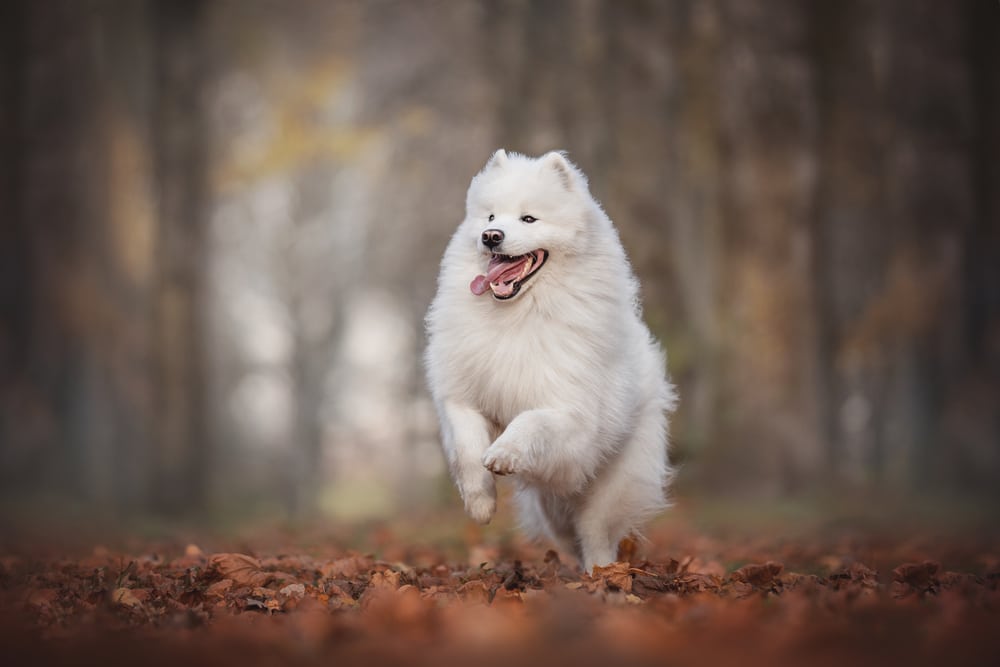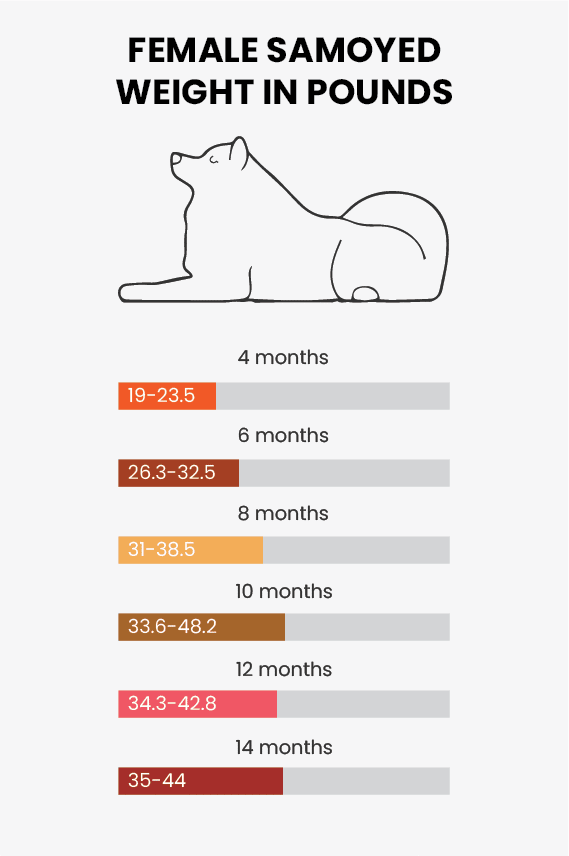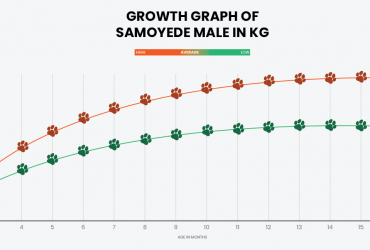There may be nothing cuter than cradling a Samoyed puppy in your arms. Their soft fluffy fur and permanent smile can melt the hardest of hearts. But, much like babies, Samoyeds do not stay puppies for long. A Samoyed growth chart can help you monitor your puppy’s development.
It’s important to monitor your Samoyed in accordance with a growth chart to ensure healthy progress. There are certain milestones your Samoyed should reach based on its age and gender, and if it’s missing these milestones, this could be a sign of an underlying problem. Paying attention to your Samoyed’s growth can help you find and treat these problems early. Let’s delve into the Samoyed’s typical growth cycle!
Table of Contents
They Just Grow Up So Fast
A Samoyed puppy is fully grown between 9 months and 1.5 years. They become a full-grown adult when they reach mental, physical, and sexual maturity. Between these ages, female Samoyeds will reach 35-45 pounds (15-20 kilograms), and males will reach 45-66 pounds (20 – 30 kilograms). Since Samoyeds were bred to be sled dogs, they require plenty of daily exercise to stay healthy and lean. In addition to exercise, they also love constant companionship. The best owner for a Samoyed is an active one. Due to their medium size, they’ll need a lot of space to stay active. An apartment dog they are not. Samoyeds thrive in large detached homes with big backyards they can run laps around. As you’ll see, gender is not the only factor determining a Samoyed’s growth.
Breaking Down The Samoyed Growth Chart: The Puppy Phase (Birth – 8 Months or 1 Year)
Before growing their thick white coats, Samoyeds start off pink. Their coats are very short and their pink skin shows through their fur. They should weigh anywhere from 10 to 18 pounds (4.5 – 8 kilograms). Within 3 to 4 days their pink noses will sport charcoal patches. Around day 14 their senses kick in as their eyes and ears open. Their weight also doubles. The charcoal patches continue to spread forming the rest of their nose and lips.
At week 3, the puppies are on their feet, but not in full exercise mode. There will be plenty of time in the future for that! Their tails begin to pull over their backs for balance. Their ears fold over and growling and barking begins. You’ll hear a lot of growling and barking when your Samoyed grows up, as this is its main communication method. Your neighbors will hear a lot more from your Samoyed when you head off to work and leave it at home for a few hours. This is also the phase where play begins, and Samoyeds love to play.
The Cute Phase & The Awkward Phase

When your Samoyed reaches the 5th week of its growth chart, start an Instagram account! This is when they are at peak cuteness. They also begin to play a lot more, in addition to eating and sleeping. The 8th to 10th week is the perfect time for a Samoyed to enter their home. Until this point, they should be with their brother and sister puppies to become stable and associated. At 8 weeks they weigh around 10 pounds (4.5 kilograms) and at 10 weeks they weigh around 15 pounds (7 kilograms).
Between 4 and 6 months is when you can put the camera away for a while. This is a Samoyed’s awkward puberty phase on its way to becoming a handsome lad. The legs and ears are out of proportion, and the pure white coat becomes too short for the length of the Samoyed’s body. However, give your Samoyed time to grow out of this phase. Any time between 9 months and 1.5 years, sometimes leading all the way into the 4th year, your Samoyed will reach maturity.
Factors Affecting Size
There are different factors that will affect the growth of a Samoyed in accordance with its growth chart. Everything from feeding and exercise levels to gender will have an impact on the adult size of a Samoyed.
Spayed/Neutered vs Unneutered/Unspayed
This is a decision left up to the owner. There is a myth that spaying or neutering your Samoyed will cause their weight to be above average compared to their growth chart. However, you should not notice your Samoyed gaining weight after its operation. If they do end up gaining weight, it could be because recovery times for the operation span from 3 to 4 weeks. This means that your Samoyed will be inactive during this time. If its diet remains steady and exercise levels decrease, you might notice your Samoyed carrying a few extra pounds. This doesn’t mean you should rush your Samoyed to get back into its exercise regime. It went through a delicate operation and needs to heal.
You might find that your Samoyed, which is a very energetic breed, is ready to run after only a few days of recovery. With permission from your vet, you can absolutely lightly exercise your Samoyed, and this should stabilize weight levels.
A Male vs A Female Samoyed On The Growth Chart
Male and female Samoyeds differ in size. As with many breeds and animals across the board, male Samoyeds will be physically larger than their female counterparts. If a female Samoyed is hitting the same weight as a male Samoyed, then it may be overfed, and she should be taken in for a checkup.
Food
What you feed and how much you feed your Samoyed will have a huge impact on their growth. No matter if you’re a first-time dog-owner, it is important to know exactly how much to feed your Samoyed. Only feed your Samoyed 2 times a day. And make sure you don’t leave their food bowl full. The best times to feed your Samoyed is when you wake up, and then 8 hours after that. You might be able to stretch this to 12 hours between meals, but this depends on how hungry your Samoyed is. The more you exercise your Samoyed, the hungrier it will be.
Samoyeds, in general, do not eat as much as other breeds of similar size. The most important feeding time is the 1st year of life. At this phase, the Samoyed will grow from around 1 pound (0.45 kilograms) at birth to anywhere from 45-70 pounds (20-31 kilograms).
Watching Your Samoyed’s Weight

You have to manage your Samoyed’s diet to prevent it from becoming overweight or underweight. You may have to add food or take some away. If your Samoyed needs to lose weight, cut portions and increase exercise. This will make your dog healthier and help them live a long and happy life. As your Samoyed grows you’ll want to give them more food, and then level it off towards the end of their growth cycle (i.e The end of their 1st year.) Food should consist of around 24% protein and 15% fat. And of course, stick to dog food instead of human food. No slipping your Samoyed any meatballs from your plate.
- Contains one 46.8 pounds bag of Pedigree High Protein Dog Food – Beef and Lamb Flavor
- Made with real red meat and 25% more protein than Pedigree Adult Complete Nutrition
- 100% complete and balanced dry food for adult dogs
- No added sugar, no artificial flavors, and no high fructose corn syrup
- Active dogs of every breed go wild for the high-protein recipe and great taste
Some owners feed their Samoyeds raw meat, which appeals to their roots, and this helps power them through growth cycles. Raw meat is good for a Samoyed’s diet and dental health. Remember, feeding a Samoyed dry food is a great option and provides your Samoyed with the right levels of nutrients.
The Weight Of The Male & Female Samoyed: Growth Chart

Outside of putting your Samoyed on a scale, there are other options to monitor their weight and growth. The best way to stay in tune with your Samoyed’s weight is to take them to the vet for a yearly checkup. At home, you can run your thumbs along the length of their spine and try to count ribs. Examine how prominent the ribs are. If there is a thin layer of fat over the ribs, and you can count them one by one, then your Samoyed should be at a healthy weight. When the ribs are too prominent, your Samoyed might be underweight. If you can’t count them at all, then your Samoyed may be overweight. Keeping your Samoyed on a balanced diet will improve their overall health and lifespan.
The next thing you can check is the size of their chest in relation to their abdomen. You should be able to see where their chest ends and their abdomen begins, as it is usually defined. If you can’t see the difference, and your Samoyed’s abdomen outsizes their chest, then it may be overweight.
Health Concerns With Overfeeding & Under Feeding
The quality and quantity of your dog food go hand in hand. If you underfeed your Samoyed it can become malnourished and lead to a flurry of health conditions. If your Samoyed does not receive the right amount of nutrients the following might occur:
- Lethargy (lack of energy, fatigue, sleeping often)
- Getting sick more often due to a compromised immune system
- Unshiny and fragile coat due to a lack of vitamins
- Body odor and foul breath
- Hair loss and skin irritation
- Diarrhea and gas
If the opposite occurs and your dog is carrying a few extra pounds, then your Samoyed can experience a different set of conditions. Your Samoyed can become obese, and wear down its joints due to the extra weight it must carry. In addition to this, your Samoyed runs the risk of contracting heart disease and diabetes. It’s similar to the conditions obese humans face. And if that’s not bad enough, your Samoyed could contract arthritis.
What If Your Samoyed Is Not Following The Growth Chart

It’s important to give your Samoyed some wiggle room when comparing it to its growth chart. If your Samoyed appears underdeveloped, book an appointment with your vet. If your Samoyed is underweight it will have difficulty growing. A vet will advise you to feed your Samoyed more. However, if your Samoyed is the appropriate weight for its age, its underdevelopment is probably related to genetics. If this is the case then visit your breeder. Ask about your Samoyed’s siblings and how they are developing. If they are also underdeveloped, then it is a genetic issue. You might also have a late bloomer on your hands, so be patient and keep feeding your Samoyed in accordance with their age and exercise levels.
Finding A Good Breeder Will Ensure Your Samoyed Follows Its Growth Chart
Any development issues can be rooted out with a good breeder. A reliable breeder is dedicated to their job and the Samoyed breed as a whole. Profit does not drive them. They derive pride from doing a great job. Talk with your breeder to understand their breeding practices. They do not pressure buyers to make a decision and they spend time with their puppies, building character, and security in relation to humans. These are the signs of a good breeder, and finding a good breeder, leads to a healthy Samoyed.
In Conclusion
Enjoy the time you have with your cute fluffy happy Samoyed puppy. They grow up fast and within a year, they will be full-grown adults. Don’t worry they’ll still hold on to their cute factor! Feed and exercise your dog appropriately while visiting your vet for yearly checkups and monitoring their weight in accordance with the average Samoyed growth chart. Your Samoyed will blossom into adulthood right before your eyes.

